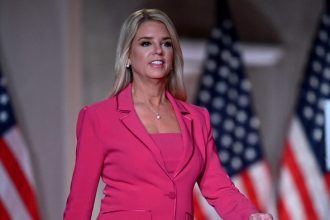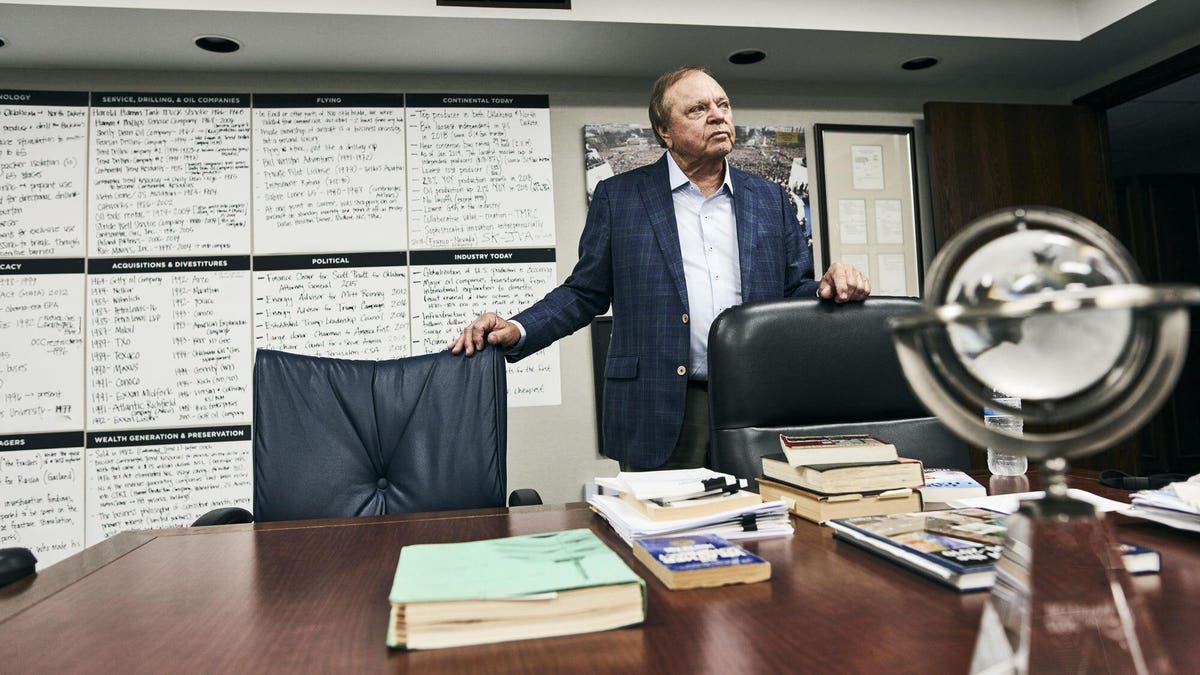Fresh from publishing his memoirs, Game Changer, the oilman hosted a high-powered Biden-bashing summit.
Harold Hamm was eating it up. Sitting at a table near the stage with his family, the 77-year-old oil billionaire listened intently as one after another of his hand-picked lineup preached to the choir at the first ever American Energy Security Summit held at the shiny new Hamm Institute for American Energy.
“Joe Biden hates American energy,” declared Nikki Haley to an audience of 350 middle-aged oil and gas executives. “When the president talks, he demonizes companies like yours. It’s anti-American, and it needs to stop.”
Haley, whose campaign and Stand For America PAC have received at least $28,000 from Hamm, promised that as president she would cut federal gasoline and diesel taxes. “Every ounce of energy we get from home we don’t have to buy from somebody else, especially our enemies.” And to help spread America’s energy bonanza around the world, she would fast track permitting for pipelines and liquefied natural gas export terminals. “We’re going to open our country’s floodgates. There’s no such thing as too much American energy.”
Hamm agrees with Haley on Biden. “Our global standing is in decline because of his moves on energy,” Hamm tells Forbes. “Biden, from his very first executive orders, has done nothing but make energy prices in this country go up while increasing national security risk,” by promoting oil development in Iran and Venezuela rather than Wyoming.
Having finished taking Continental Resources private, and after publishing his book, Game Changer, last month, Hamm figured that the perfect time to hold the first ever energy summit at his new institute (funded by his $50 million gift to Oklahoma State University) would be the Monday following the U.N. Climate Week in New York— as if some of us frequent flyers needed an antidote to what he sees as a naive belief among climate activists that we can just quit fossil fuels.
Among the highlights, David Solomon, CEO of Goldman Sachs, rejected any notion that Wall Street should stop financing oil companies. “We have to support traditional energy. If we don’t have reliable energy at an affordable price society won’t function,” said Solomon.
The message from Big Oil companies was that a low-carbon transition will not happen without them. “We’re not the enemy,” said Mike Wirth, CEO of Chevron. “If you exclude this industry, I guarantee that you will not meet the goals you want.” It’s crazy, Wirth added, “to pretend it’s possible to build a new energy system without leveraging the old one.”
“Transition is the wrong word; it’s and, and, and,” offered Baker Hughes CEO Lorenzo Simonelli, insisting that fossil fuels are not going to be replaced, but supplemented.
Former Trump Secretary of State Mike Pompeo lambasted Biden administration efforts to promote electric vehicles powered by batteries and solar panels — categories dominated by China, which for all of its green hype, last year burned a record 5 billion tons of coal, after adding more coal power in the past five years than is in the entire United States. “No chance China is going to cut,” said Pompeo. “[President Xi] is going to build coal fired [power plants] as long as economically viable. He will not commit climate change hari-kari.”
As Hamm sees it, Biden is holding American energy hostage. He resented White House threats last year to impose a windfall profits tax after oil spiked with the start of the Ukraine war. And he thinks the administration was foolish to tap 180 million barrels from the Strategic Petroleum Reserve when there wasn’t any real oil shortage. “The SPR is meant to be a reserve for times of war, not of politics,” says Hamm.
Worse, it’s a trick you can only do once. The beneficiary of Biden’s oil policy is the Saudis, says oil analyst Amrita Sen of Energy Aspects, who told the summit that the Saudis are “revenue optimizers and maximizers” and are making $70 million per day more under premium pricing than before they cut output by 2 million barrels per day — purposefully tightening the global oil market because America’s SPR is no longer a threat.
***
Hamm is not a charismatic public speaker. His gravelly drawl can be hard even for midwesterners to parse. Which is why he wrote down what he needed to say in his new book Game Changer: Our 50-Year Mission To Secure America’s Energy Independence. He insists he’s not calling himself a “game changer.’’ Instead, he says, his book’s title refers to the combination of horizontal drilling and hydraulic fracturing that has come to be known as fracking. That’s a term Hamm hates as much as being called a fracker, which to his ear sounds pejorative and disrespectful to the technology’s significance in helping make the United States the world’s biggest oil producer (12.8 million barrels per day).
He organized the book in his inner sanctum — a windowless room on the 13th floor of Continental Resources’ Oklahoma City headquarters lined with boxes of records, clippings, photographs and awards. He has filled hundreds of yellow legal pads over six decades and appears to still have them all.
Around the walls is posted a long timeline, stretching back decades. Perhaps his most precious artifact is a term paper he wrote in high school, titled “Oil.” Encouraged by teacher James E. Hunter to explore his curiosity, a teenaged Hamm wrote 20 pages in a neat cursive script. It’s impressive work, especially for a kid who was the youngest of 13 and grew up barefoot picking cotton on an Oklahoma farm. The project birthed his lifelong obsession for finding oil.
He did it the hard way. A college drop out and largely self taught geologist, Hamm started off with a trucking company 56 years ago, hauling away oily flowback water from drilling sites, skimming crude off the top to make a few bucks. He put one million miles on his truck before ever drilling his first well. His daughter Shelly Lambertz wrote an Afterward for the book, recalling “the countless wristwatches Dad would go through because oil seeped inside them.” He’s since become the world’s richest truck driver, with a family fortune of some $25 billion.
Hamm really got going around 1995 when he first began experimenting with steerable drilling in the Cedar Hills oil field of Montana. It was his first time drilling so-called “tight” rock, low in porosity and permeability. Frustrated that conventional vertical drilling methods didn’t work, he tried then-new technology enabling drillers to steer their bits — first down, then turn 90-degrees sideways to bore for a couple miles through oil-filled rock. It worked like a charm, with wells producing 900 barrels per day. “That opened up all the tight oil reserves in America.” In 2007, in order to raise cash to drill in North Dakota’s Bakken shale, Hamm took Continental public, selling 15%.
Hamm was distracted but undeterred by anti-fracking activists like Josh Fox, who made the 2010 movie “GasLand.” He considers it part of a smear campaign against U.S. natural gas led by Russia, which lamented losing LNG market share to the frackers. For evidence, Hamm points to a 200-page report prepared in 2018 for the U.S. Senate Foreign Relations Committee detailing NATO intelligence that Russian intelligence agents provided support for anti-fracking environmental groups including funding NGOs with $95 million.
Hamm considers perhaps his greatest accomplishment the incessant lobbying he undertook ahead of the 2015 legislation that lifted a federal ban on the export of domestic crude oil, allowing independent producers like Continental to cut out middlemen and sell their crude directly to international buyers. He predicted to Forbes a decade ago that the U.S. oil industry would double output of crude oil and other raw liquids like propane. And so it has, to nearly 20 million barrels per day.
Meanwhile, natural gas production keeps growing, to more than 110 billion cubic feet per day. Burning natural gas releases just half the carbon dioxide emissions for the same energy as coal. As shale gas has displaced coal in power generation, the U.S. has reduced carbon emissions by some 15% over the past 20 years — the greatest volumetric and percentage carbon reduction by any developed nation. It’s proof positive for Hamm that frackers aren’t part of the climate problem, but the solution.
Even better, America is exporting record amounts of gas — last year sending 12 billion cubic feet per day as LNG to Europe, where it displaced Russian supplies. As Robert Pender, founder of Venture Global LNG, told the summit crowd, “we can do the same miracle worldwide.”
Hamm’s biggest play in recent years (after perhaps writing a $975 million check to settle his 2015 divorce from Sue Ann) was last year’s move to take Continental Resources private. He says that even though his family already controlled 80% of the shares, raising $4.3 billion to buy in the rest was a no brainer, given that the equity markets were valuing Continental at just four times annual earnings. He says his top priority now is paying off debt, which should take a couple years.
Already the nation’s biggest private oil operation, Continental is closing in on 500,000 barrels per day. While they operate some 23 rigs, among the most nationwide, Continental CEO Doug Lawler cautions that there’s no drill-baby-drill ethos here. They’re about generating value, not volumes. The biggest boon of going private: not dealing with investors and analysts has freed up at least 20% of executives’ time.
***
Easily the most intriguing discussion at the summit was when Hamm went up on stage to chat with Vicki Hollub, CEO of Occidental Petroleum. They have some interests in common. Oxy, in the Permian basin, is developing technology to suck carbon dioxide out of the air using so-called direct air capture machines. Oxy will add that CO2 onto a pipeline network that it operates in west Texas, and will also hook up a new electric generating plant it is building in a venture with NETPower — the novel plant combusts natural gas, but captures all of the resultant CO2 rather than letting it waft into the air. Oxy will take all this captured CO2, pressurize it, and inject it deep into old oil fields where the gas will goose out additional quantities of oil while getting trapped permanently in the rock.
This is a technique that Oxy has been perfecting for decades in west Texas, and which Hollub believes will work in their fields in Colorado, Wyoming and Oman. “We will apply carbon dioxide to shale,” Hollub says. “There is still three times more shale recovery to go.”
Hollub is not as knee-jerk dismissive of ESG concerns as some of the summit speakers — because she thinks sequestering carbon dioxide underground is a viable engineered solution to the problem that will give Oxy “social license to operate.”
Speaking on a separate panel, Chris Kendall, CEO of Denbury Resources (soon to be acquired by ExxonMobil) explained that for decades they’ve been pioneering carbon dioxide injection along the Gulf Coast; their objective is to “pre-offset the emissions” from oil by sequestering more CO2 than the oil would eventually produce when used as gasoline or diesel. They call it “blue oil.”
Hamm agrees, which is why Continental has invested $250 million into a project that will take CO2 produced at 34 corn ethanol plants across the midwest and move it by pipeline to North Dakota where they’ll inject it into porous rock layers that are naturally free from oil and gas deposits. Gov. Doug Burgum, speaking at the summit, said he expects “North Dakota’s geologic jackpot” to attract $40 billion in carbon sequestration investments.
“At these ethanol plants all the CO2 generated is just going out into the air,” says Hamm. “Why not capture that and sequester it and not pollute the air. It’s the right thing to do.”
Read the full article here





